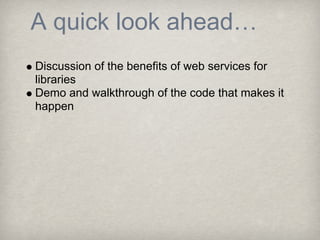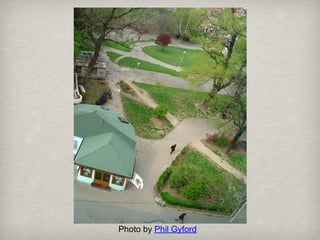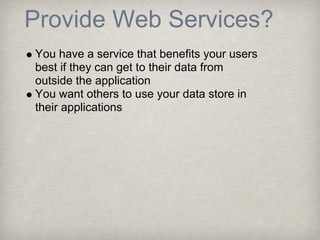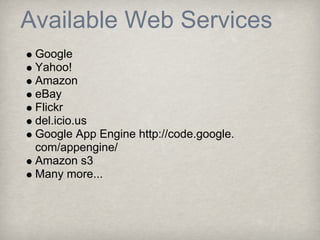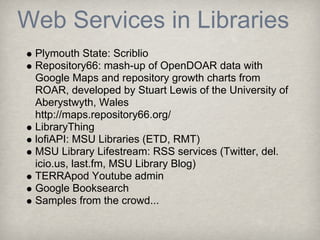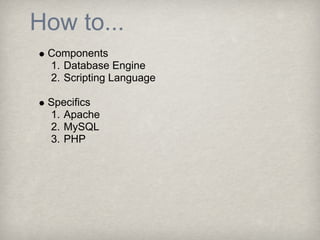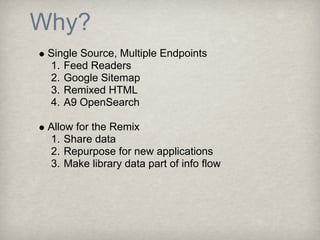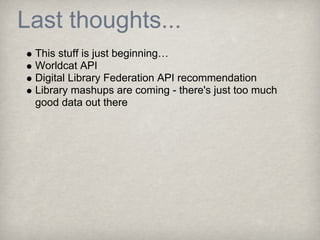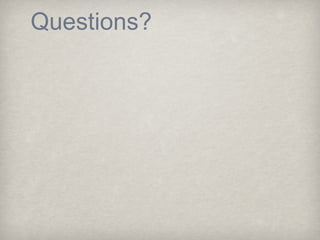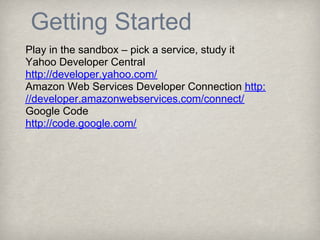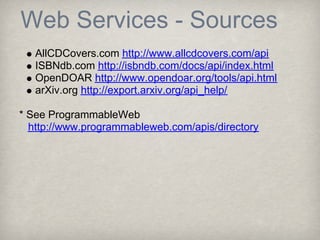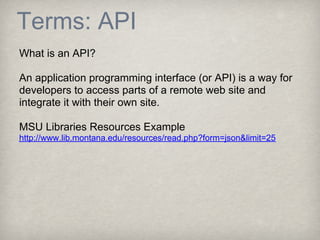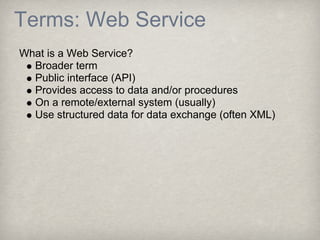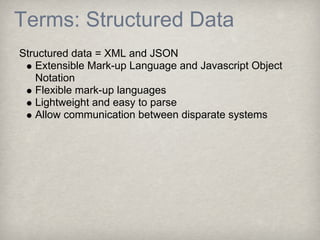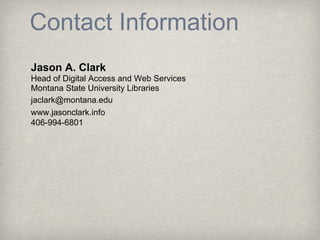A "lofiAPI": Using open source applications and simple XML to build a library web service
- 1. A quot;lofiAPIquot;: Using open source applications and simple XML to build a library web service Jason A. Clark Head of Digital Access and Web Services Montana State University Libraries
- 2. A quick look aheadŌĆ” Discussion of the benefits of web services for libraries Demo and walkthrough of the code that makes it happen
- 3. Photo by Phil Gyford
- 4. Provide Web Services? You have a service that benefits your users best if they can get to their data from outside the application You want others to use your data store in their applications
- 5. Demos and Downloads Demo: A quot;lofiAPIquot; for Library Data http://www.lib.montana.edu/%7Ejason/files/api/lofi/ Download: A quot;lofiAPIquot; for Library Data http://www.lib.montana.edu/%7Ejason/files/api-lofi. zip
- 6. Available Web Services Google Yahoo! Amazon eBay Flickr del.icio.us Google App Engine http://code.google. com/appengine/ Amazon s3 Many more...
- 7. Web Services in Libraries Plymouth State: Scriblio Repository66: mash-up of OpenDOAR data with Google Maps and repository growth charts from ROAR, developed by Stuart Lewis of the University of Aberystwyth, Wales http://maps.repository66.org/ LibraryThing lofiAPI: MSU Libraries (ETD, RMT) MSU Library Lifestream: RSS services (Twitter, del. icio.us, last.fm, MSU Library Blog) TERRApod Youtube admin Google Booksearch Samples from the crowd...
- 8. How to... Components 1. Database Engine 2. Scripting Language Specifics 1. Apache 2. MySQL 3. PHP
- 9. Why? Single Source, Multiple Endpoints 1. Feed Readers 2. Google Sitemap 3. Remixed HTML 4. A9 OpenSearch Allow for the Remix 1. Share data 2. Repurpose for new applications 3. Make library data part of info flow
- 10. Last thoughts... This stuff is just beginningŌĆ” Worldcat API Digital Library Federation API recommendation Library mashups are coming - there's just too much good data out there
- 11. Questions?
- 12. Getting Started Play in the sandbox ŌĆō pick a service, study it Yahoo Developer Central http://developer.yahoo.com/ Amazon Web Services Developer Connection http: //developer.amazonwebservices.com/connect/ Google Code http://code.google.com/
- 13. Web Services - Sources AllCDCovers.com http://www.allcdcovers.com/api ISBNdb.com http://isbndb.com/docs/api/index.html OpenDOAR http://www.opendoar.org/tools/api.html arXiv.org http://export.arxiv.org/api_help/ * See ProgrammableWeb http://www.programmableweb.com/apis/directory
- 14. Terms: API What is an API? An application programming interface (or API) is a way for developers to access parts of a remote web site and integrate it with their own site. MSU Libraries Resources Example http://www.lib.montana.edu/resources/read.php?form=json&limit=25
- 15. Terms: Web Service What is a Web Service? Broader term Public interface (API) Provides access to data and/or procedures On a remote/external system (usually) Use structured data for data exchange (often XML)
- 16. Terms: Structured Data Structured data = XML and JSON Extensible Mark-up Language and Javascript Object Notation Flexible mark-up languages Lightweight and easy to parse Allow communication between disparate systems
- 17. Contact Information Jason A. Clark Head of Digital Access and Web Services Montana State University Libraries jaclark@montana.edu www.jasonclark.info 406-994-6801


